Men are buying more jewelry than ever. These celebrities are embracing the trend.
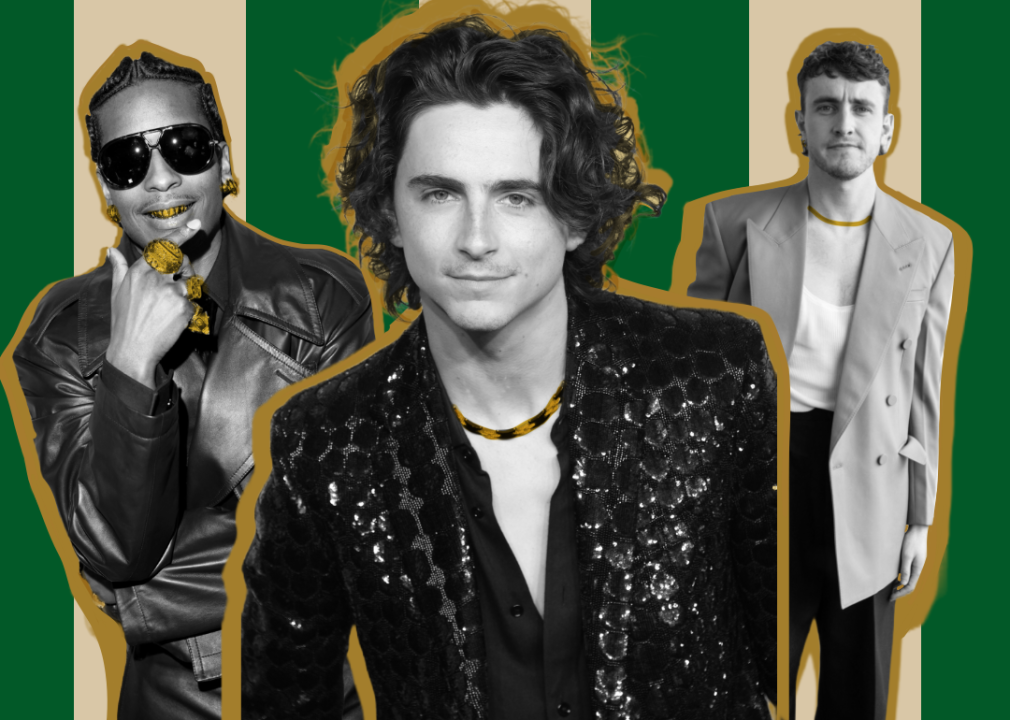
Photo Illustration by Elizabeth Ciano // Stacker // Getty Images
Men are buying more jewelry than ever. These celebrities are embracing the trend.
Timothée Chalamet, A$AP Rocky, and Paul Mescal collage.
Vanity and the act of adorning the body are generally ascribed to women. In fashion, womenswear is where radical, boundary-pushing ideas usually reside. Meanwhile, men have strived to hide their interest in fashion for the last century (at least), often wearing garments that deviate ever so slightly from the standard to subtly telegraph an interest in style.
Still, one thing has changed: Men are starting to swim more deeply into experimental waters.
While there have always been male boundary-pushers in every generation (see the dandies of the 18th century, the New Romantics of the ’80s, and RuPaul of the ’90s), it’s Generation Z who has confidently removed even more of the societal structures of male dressing. This new cohort of young men (both born and self-identifying) are painting their nails, wearing statement bags (some still cling to the aging term “purse”), and exploring new silhouettes regardless of a previously assigned gender.
The RealReal investigated the rising trend of men’s jewelry and its male connoisseurs, using news reports, trade publication data, and other sources to find the catalysts behind this new development.
Interest in men’s jewelry has been rising—and the sales figures prove it. According to Euromonitor (and as reported in Vogue Business), men’s fine jewelry reached about $7.3 billion and grew 7.3% versus the $44 billion behemoth that is women’s jewelry, which only grew 4.6%. Polaris Market Research estimated the men’s jewelry market to be worth even more globally at $34.33 billion in 2023 and is anticipated to grow 8.4% from 2024 to 2032.
According to PMR, key reasons for such bullish forecasts include a growing awareness of fashion and changing norms around masculinity in society. Not only that, but men’s jewelry isn’t just about rings and wedding bands anymore. It has broadened to include leather bracelets, signet rings, and cuffs.
This emerging revenue-generating territory has caught the attention of blue-chip fashion players like Louis Vuitton, who launched its men’s fine jewelry line Les Gastons Vuitton in 2024. Prices for the collection start at roughly $2,000 and top off at $42,500. Others have entered this arena as well, like David Yurman, whose brand offers a 40-carat diamond bracelet for $295,000, or Lagos, whose Anthem collection features skulls, daggers, and snakes and starts at a more accessible $150.
Though Gen Z has run with this newfound confidence in dressing, the men of hip-hop have a long American history of countering traditional norms of male dress. So much about the culture of hip-hop or rap is rooted in the psychological tussle of class, money, inferiority, aspiration, and outward presentation. The result is usually ostentatious “bling bling,” a term popularized by the rapper Lil Wayne (and coined by his Cash Money brethren B.G.). “LL Cool J is another example of gold rope chain excellence. He was also one of the first to popularize four-finger rings, but it was Biz Markie who took it a step further, flooding his with diamonds … Ben Baller, of IF & Co. Jewelry, estimated the value of those chains at $100,000… each!” Highsnobiety’s Donovan Barnett wrote.
Hip-hop (and its form of expression and product, rap) has changed. As it has moved past its infancy to become the music of the mainstream, so, too, has the culture matured in the way it uses fashion and, particularly, jewelry. Experiencing this change in American society is Gen Z, who have been unapologetic in using jewelry as an effective punctuation to their style, following those in the limelight.
Here are a few celebrities from then and now who have inspired them.
![]()

Gareth Cattermole // Getty Images for Warner Bros. Pictures
Timothee Chalamet
Timothee Chalamet attends the premiere of “Wonka”.
Hollywood is often characterized by its stereotypes, not least of which affect what it means to be a “male movie star.” Still, Timothée Chalamet seems to have hurdled this major obstacle with aplomb. He caught the world’s eye with his 2017 breakout role in “Call Me by Your Name” as Elio, a teen boy entangled with his father’s older male intern (Armie Hammer).
Since then, he’s led the charge of what writer Anne T. Donahue has called “artthrobs,” and his less-hypermasculine demeanor also affects their fashion choices. His fans know to expect something different when it comes to Chalamet’s sartorial choices, especially jewelry. He’s paired a 1955 Cartier Tradition brooch with a Prada Re-Nylon jacket and worked with the fashion house on both a custom “Wonka” and “Dune” necklace. As Esquire noted, the star is rarely seen without statement neckwear.
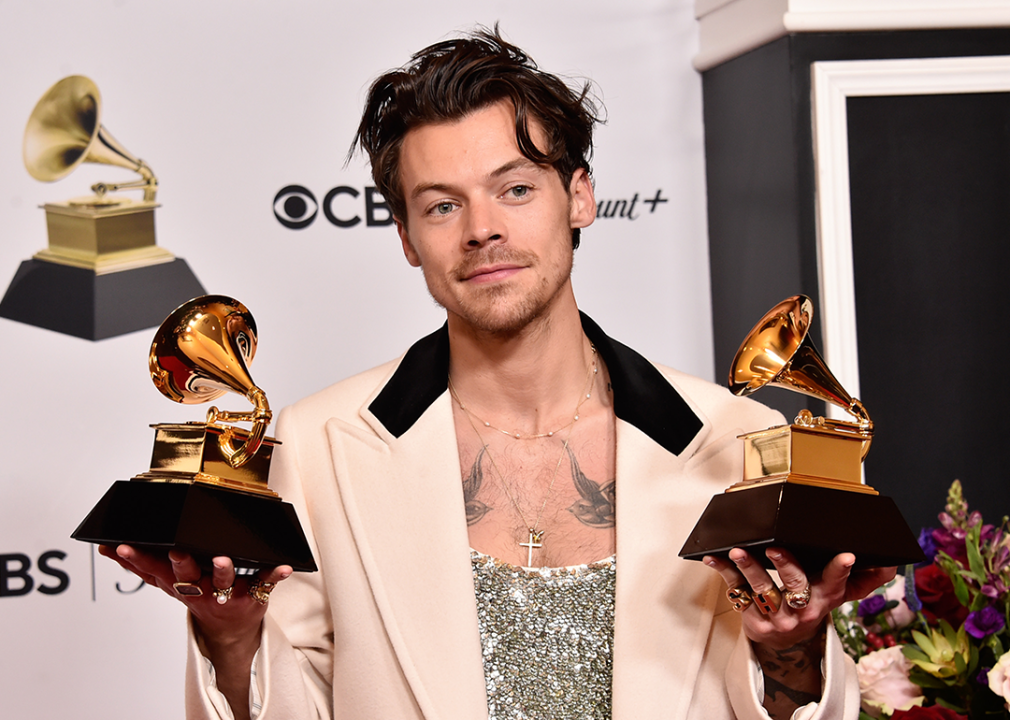
Alberto E. Rodriguez // Getty Images for The Recording Academy
Harry Styles
Harry Styles poses with Grammy Awards.
Only 16 when he became a pop idol as part of the group One Direction, Harry Styles has come a long way from launching his solo career in 2017 to becoming a fashion icon who dares to break down gender stereotypes. Styles has been known to sport ballet outfits, red sequined jumpsuits, and even a Gucci dress for the cover of Vogue in 2020.
The musician frequently sports pearl necklaces, and for the 2019 Met Gala, he boldly wore a single pearl earring matched with a sheer ruffled blouse—stirring because of its association with Johannes Vermeer’s sensual 17th-century painting “Girl with a Pearl Earring.”

Amy Sussman/GA/The Hollywood Reporter via Getty Images
Paul Mescal
Paul Mescal attends the 2023 Film Independent Spirit Awards.
Irish actor Paul Mescal didn’t set out with an eye toward fashion. It found him while starring in the critically acclaimed Hulu miniseries “Normal People.” In the show, Mescal’s character, Connell, is an “Irish hunk” with lackluster communication skills—tough but tender inside. The silver chain Connell wears has come to encapsulate this contradiction. The fascination with the accessory became so heated that it inspired its own Instagram account.
Since then, Mescal has stepped up to the fashion plate, bringing his fans—and brands—along with him. In 2020, when the actor sported an Otiumberg oval-engraved pendant, brand sales for men’s jewelry reportedly spiked 337%, according to Women’s Wear Daily. He’s now an ambassador for both Cartier and Gucci. Known for his trendy shag mullet hairstyle and white ribbed tanks, Mescal will undoubtedly need to finish off his looks with just the right piece of jewelry.
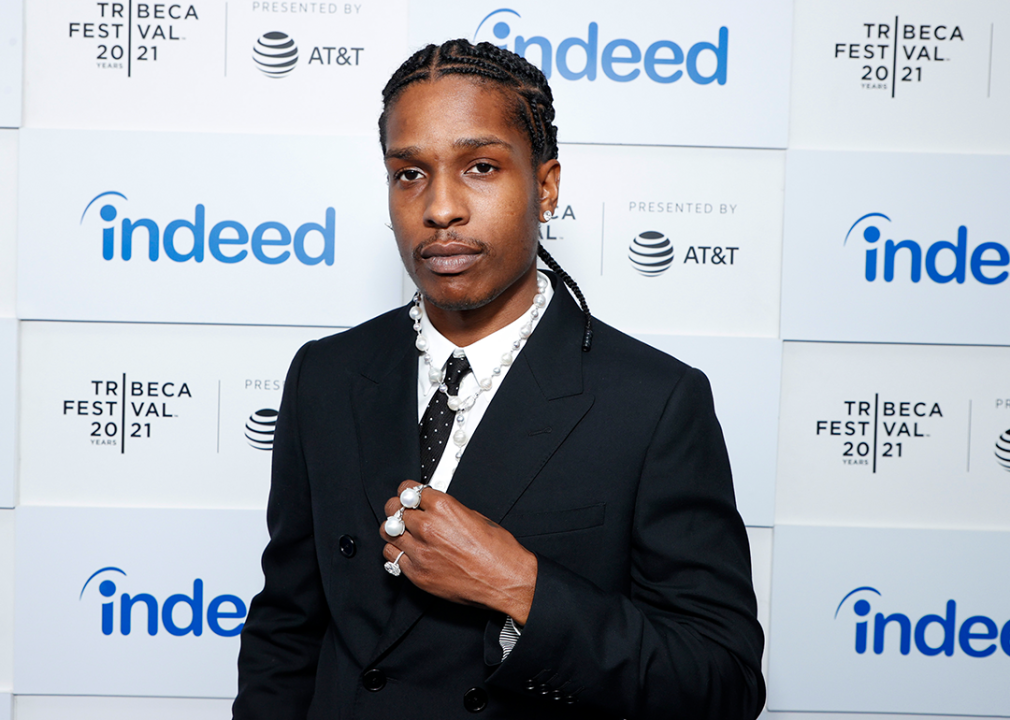
Arturo Holmes // Getty Images for Tribeca Festival
ASAP Rocky
A$AP Rocky attends 2021 Tribeca Festival Premiere of “Stockholm Syndrome”.
A hip-hop maverick, A$AP Rocky came onto the scene in the early 2010s, when he caught people’s attention with his music and flair for fashion. He’s been in campaigns for Alexander Wang and Dior Homme and has released collections for Guess and J.W. Anderson. The artist has been seen sporting oversized pink suits to babushkas (head scarves typically worn by Russian and Polish grandmothers).
Of course, these outfits have only been polished with some additional bling. A$AP Rocky’s previous jewelry choices include a 6mm pearl necklace (a subtle piece that can be worn with most everyday clothing), a dice choker featured in his music video “Praise the Lord (Da Shine),” and even unique grills, many of which were custom made by a Tetsuya Akiyama in Tokyo’s Okachimachi district.
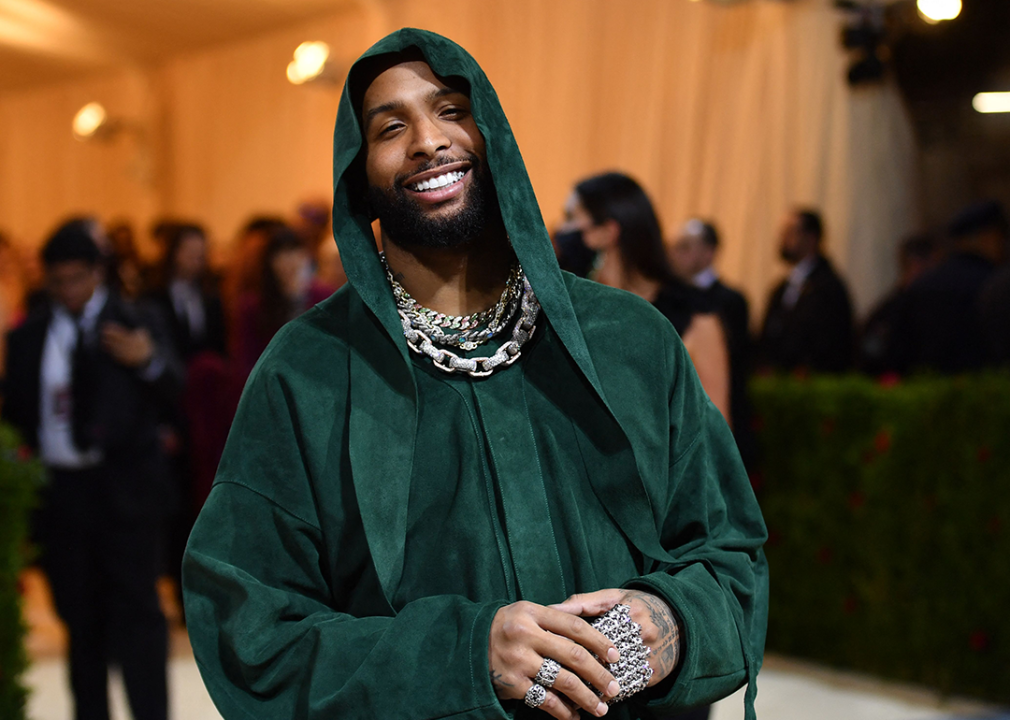
ANGELA WEISS/AFP via Getty Images
Odell Beckham Jr.
Odell Beckham Jr. arrives for the 2022 Met Gala.
Sports isn’t just an arena for athleticism. In modern society, it’s also become a lucrative stage where influence can be cultivated, which is why many athletes crossover to fashion. There used to be a time when men’s jewelry was just about signet rings and diamond studs, but “now it’s much more about creating a look that’s your own. … Athletes are really at the forefront of it,” Reed Krakoff, creative chairman of John Hardy, told Bloomberg.
Miami Dolphins wide receiver Odell Beckham Jr. is an example of this fashion-football crossover. He’s sported his sophisticated style at Met Gala and Oscar parties alike. He’s paired forest-green suede outfits with ostentatious diamond necklaces and white-on-white tuxes with a tasteful jewel pin on his blazer pocket. It’s all part of how he’s challenging the norms in sports and fashion. He told Esquire: “People like to put me in a box as just an athlete, so it’s cool to experiment and show people a different perspective.”

Chris Polk/FilmMagic // Getty Images
Dennis Rodman
Dennis Rodman during Maxim Magazine’s Hot 100 Arrivals in Hollywood.
In the ’90s, basketball star Dennis Rodman provided an alternative to the status quo questioning of hip-hop jewelry styles. Instead of countless necklaces around his neck, Rodman used the flesh of his face as a canvas. The basketball star’s mostly silver piercings—in the ears, nose, and down the center of his bottom lip—served as a statement and representation of the anti-establishment and transgressive attitude of the transitory decade.
Even today, Rodman’s representation of gender seems forward-thinking. His sartorial choices, which include feather boas and, yes, pearl necklaces, have set the stage for more varied views of Black masculinity. The sports star attributes this to growing up around women. “I hung out with my sisters all the time, and they was just trying to make me dress up,” he told GQ. “So I was like the guinea pig of the family.”
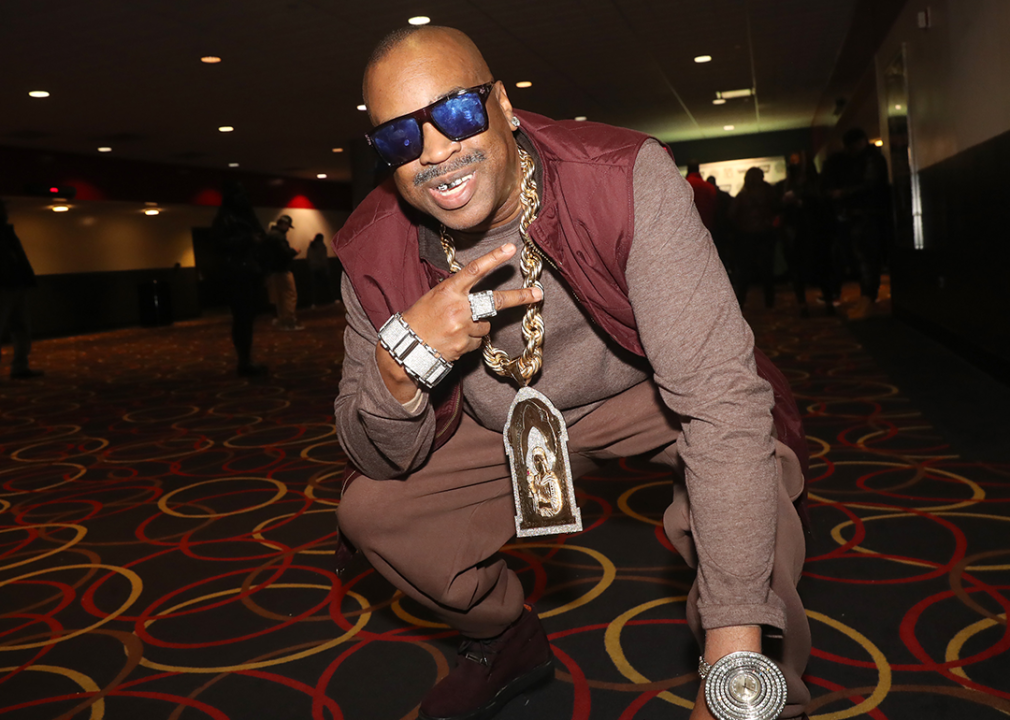
Johnny Nunez/WireImage // Getty Images
Slick Rick
Slick Rick poses for photographers at aevent.
London-born rapper Slick Rick, who rose to fame in the 1980s, became the unknowing godfather of bling. He layered gold chains, fat Cuban links, car ornament-size chest pieces, and expensive-looking “bust-down” chains, a chain necklace whose surface is completely embedded with diamonds.
“[It] was jewelry that was the most massive thing of all. Displaying our opulence affirms the traditions and wealth of our culture. I adore the stuff because I feel it in my DNA,” the rapper wrote for The Guardian. “It’s a measure of how visual hip-hop is that we believe in the power of jewelry to communicate who we really are, a practice that dates back to the earliest folks in the hip-hop game.”

Jason Merritt/FilmMagic // Getty Images
Paul Wall
Paul Wall poses with jewelry for photographers at BET 25th Anniversary Show.
The Houston-based rapper Paul Wall makes the list because of his intersectionality. He’s white, steeped in Black American hip-hop culture, and personifies the “grills” phenomenon that swept through rap and popular culture in the early aughts.
Grills have a long history, from the Etruscans, who inlaid gold onto their incisors, to the Mayans, who used jade instead. Teeth ornamentation has been found in Southeast Asia, particularly the Philippines, all the way to the West Indies.
For Jamaicans, in particular, grills are the upmarket result of bad teeth. Due to poverty, many in the lower-income areas capped their teeth with gold and silver, which then became a fashion statement, even without a medical need.
Wall, having thrust grills into the mainstream, is now a veteran entrepreneur who designs and produces them for a niche segment of dental-minded followers of hip-hop and/or Black-inflected culture.
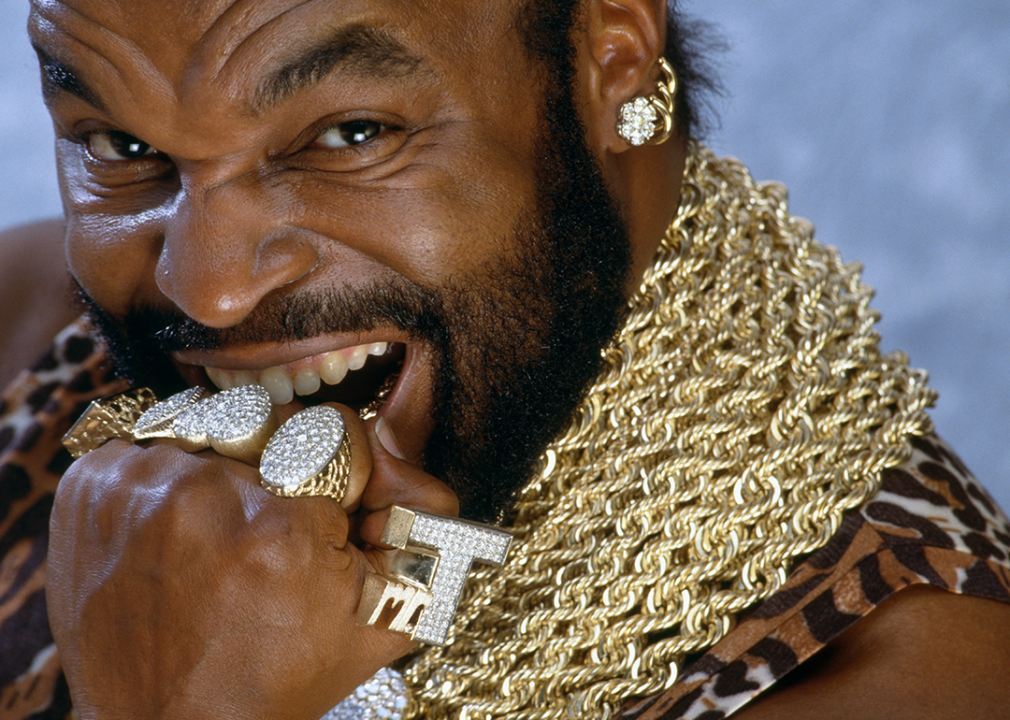
Eric Robert/Sygma/Sygma via Getty Images
Mr. T
Mr. T poses with rings.
One of the most recognizable figures from American monoculture—when only a handful of channels were available to the public—Mr. T used jewelry to amplify his outsized character. Multiple gold necklaces piled high across his muscled torso and neck, deep voice, tall physical stature, dark complexion, and mohawked hair made a look that was iconoclastic and made a mark on the face of popular culture.
The beginning of his jewelry-specific style is a funny one. Before fame, as a bouncer, Mr. T would collect and then wear the gold chains and jewelry left by the club patrons he worked for. After a while, his collection started to pile up to resemble Aladdin’s cave.
He continued using the style because of the deeper meaning that gold jewelry has for him. “When my ancestors came from Africa, they were shackled by our neck, our wrists, and our ankles in steel chains. I’ve turned those steel chains into gold to symbolize the fact that I’m still a slave, only my price tag is higher,” the celebrity wrote in his 1984 autobiography, “Mr. T: The Man with the Gold,” as reported by VT.

Jessica Koscielniak // The Washington Post via Getty Images
Flavor Flav
Flavor Flav poses for portrait at the Paris 2024 Olympics Games.
The most powerful global brands have a recognizable symbol: Chanel and the camellia flower, Gucci and the horsebit, Ralph Lauren and the polo player, and Apple and its (former) munched-on forbidden fruit. Flavor Flav is a rare individual who has one as well: the clock.
At first, wearing such a banal piece started as a joke for the Public Enemy co-founder. It became part of his identity when he wore one to open for the Beastie Boys at a 1986 New Jersey show. Now, navigating a career as an “elder” of hip-hop, Flav’s signature clocks have become a universal personal symbol. His latest iterations reflect his material success, as they now come paved in diamonds, a long way from the beginning when it was an actual clock.
Looking back, Flav gave another reason for sporting the timepiece on an episode of “Pawn Stars”: “The reason why I wear this clock is because time is the most important element, and when we stop, time keeps going.”
Story editing by Carren Jao. Additional editing by Kelly Glass. Copy editing by Paris Close.
This story originally appeared on The RealReal and was produced and
distributed in partnership with Stacker Studio.
